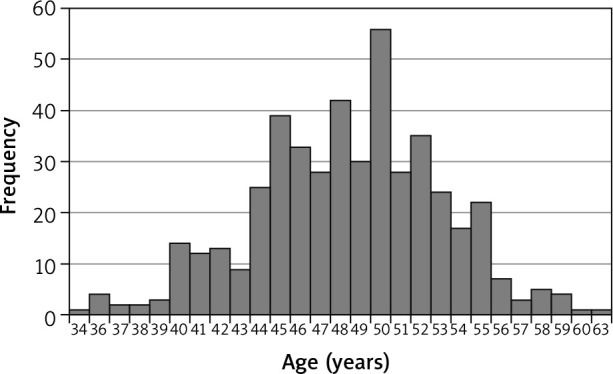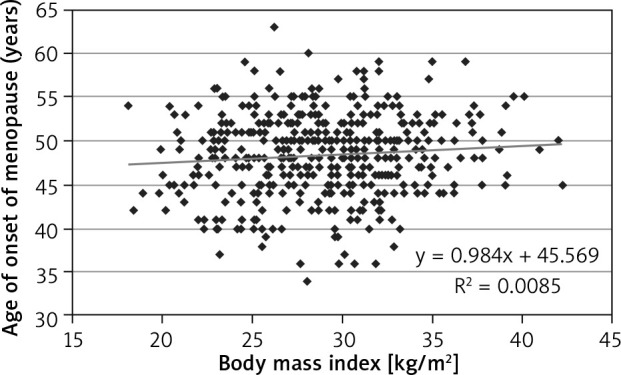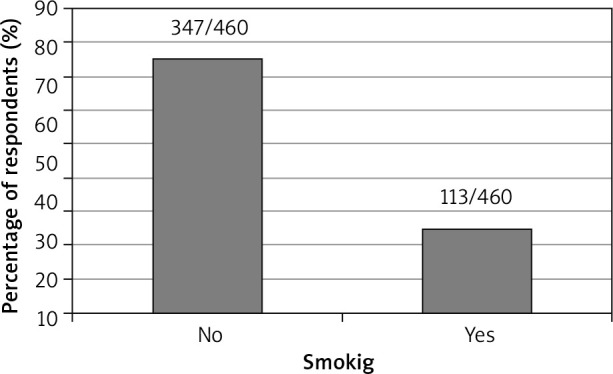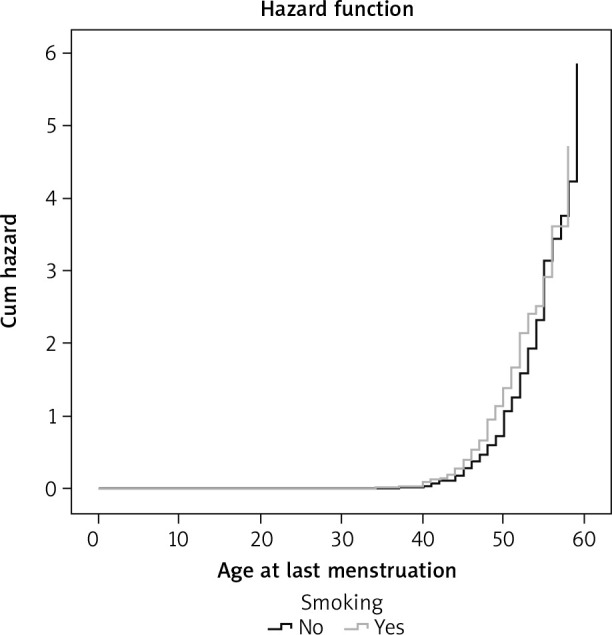Abstract
Introduction
Menopause is the last physiological menstrual period and is a complex process involving the following: endocrine, genitourinary, cardiovascular, and locomotor system, and it leads to vasomotor symptoms and psychological complaints. This study aims to investigate the influence of smoking and body mass index (BMI) as risk factors on the age of onset of menopause in women in Bosnia and Herzegovina.
Material and methods
This study included 460 women in natural menopause. The study was conducted in 2 phases: interview and measurement of BMI. Each patient underwent an interview based on the questionnaire, following the verbal consent of the patient, who had previously been explained the nature of the research.
Results
The age at which menopause occurs increases with the BMI increase, and it can be described by the regression equation: age = 0.096 × BMI + 45.7, which has statistical significance. The mean age of menopause occurrence in current smokers was lower (47.5 ±0.4 years) than in non-smokers (48.8 ±0.2 years) (p = 0.010).
Conclusions
Our study confirmed the statistically significant correlation between smoking, BMI, and age of onset of menopause.
Keywords: body mass index, smoking, menopause
Introduction
The age of natural menopause, which may have a broad range of 40–60 years in a population, is mainly dependent on genetic background and is influenced by socioeconomic factors [1]. Despite a positive association that was found between body mass index (BMI), smoking, and age at natural menopause in some studies, it has not been observed in others [1].
Early menopause, defined as the cessation of ovarian function before the age of 45 years, is associated with higher risk of cardiovascular disease, psychocognitive decline, osteoporosis, and mortality [2]. Earlier studies found modest associations between being underweight and earlier age at menopause, and being overweight or obese and later age at menopause [2]. However, the majority of studies were limited by their cross-sectional and retrospective design, with the authors noting the need for more studies better controlled for smoking and other sociodemographic factors [2].
Controversial results are reported in the literature on the relationship between menopause and body changes [3]. A higher level of physical activity, lower parity, and higher level of education were shown to be important to reduce the impact of the increase in BMI in pre- and post-menopausal women [3]. Early menarche and parity were the strongest predictors of obesity in women aged 40 to 65 years [3]. In study by França et al., obesity was found, according to BMI, in 32.0% of women, and the prevalence was higher in sedentary, physically inactive women and in those who reported ≥ 3 births [3].
Obesity is a serious health problem that tends to increase. With aging occurs the redistribution of adipose tissue from the genitofemoral part to the abdominal part, resulting in weight gain caused by decreased energy consumption, decreased fat oxidation, increased insulin resistance and decreased lipolysis, as well as increased cortisol hormone [3, 4].
Smoking is the most common way to consume tobacco. Nicotine and carbon monoxide from cigarettes can either directly accelerate ovarian follicle deterioration or may have an indirect effect on the pituitary gland by enhancing the production of follicle-stimulating hormone (FSH), which additionally has an exhausting effect on ovarian, since high serum FSH values are consistent with ovarian failure [5–7]. Regarding the smoking habit, some studies show lower mean BMI values in smokers compared to non-smokers, and that there could be a tendency towards weight gain in those who quit smoking [3].
To the best of our knowledge, few researchers have explored the important association between BMI, smoking, and age of natural menopause.
This was the first research in our area with the aim to investigate the age of onset of menopause and the influence of certain factors on the onset of menopause in women who live in Tuzla Canton in Bosnia and Herzegovina. This study aims to investigate the influence of smoking and BMI as a risk factor on the age of onset of menopause in women in Bosnia and Herzegovina.
Material and methods
The study was designed as a cross-sectional multicentre study that included 460 women undergoing natural menopause, who underwent regular gynaecological examinations in the Tuzla Canton, Bosnia and Herzegovina. The basic criterion for inclusion in the study was that the woman is in the natural menopause, i.e. that it has been more than a year since last menstruation. Exclusion criteria were all types of menopause that are not natural: after surgery, radiation, chemotherapy, or hormone therapy.
In our study, we were guided by the definition of menopause in the NICE guidelines: a clinical diagnosis made retrospectively in women who are healthy, except that they have menopausal symptoms and the absence of a menstrual cycle for at least 12 months, are considered menopausal [8]. Each participant was verbally informed of the nature of the research and interviewed on the basis of the questionnaire with written consent to participate in this research according to the norms of ethical medical research. The study was conducted in 2 phases:
interview,
measurement of body weight and height.
Women recalled their last menstrual period retrospectively.
Nutritional status was assessed by determining the BMI based on the Qeuetelet Index (Devenport-Kaup modification) or: BMI = body mass in kilograms/the square of the body height in metres. Body weight and height were measured using a scale with a “SECA” altimeter.
Statistical analysis
Statistical analysis of data was carried out by the usual statistical methods of descriptive statistics, using regression models and the “hazard ratio” for the period of life compared to the individual parameters. To analyse the association between BMI and the age at which menopause occurs a linear regression model was used. For comparison of means of age of occurrence of menopause among the groups of women, defined on the basis of different factors (smoking), we used the t test for independent samples or analysis of variance (ANOVA). The results were interpreted as a regression coefficient with the corresponding 95% CI, and the regression equation was calculated for the prediction of age at onset of menopause on the basis of BMI. Statistical significance was confirmed at p < 0.05. For processing of data, we used the statistical programme PASW 18 (SPSS Inc., Chicago, Illinois, SAD) and R programming language for statistical data processing (R Development Core Team, 2008).
Ethical approval and consent to participate
All subjects gave their informed consent for inclusion before they participated in the study. The study was conducted in accordance with the Declaration of Helsinki, and the protocol was approved by the Ethics Committee of the University Clinical Center Tuzla.
Results
This research included 460 patients who were in the natural menopause, aged from 34 to 89 years, with an average age of 60.9 ± 8.7 years. The average age (arithmetic mean) of onset of menopause in the study group among women was 48.5 (±4.6) years, as presented in Figure 1.
Fig. 1.

Age at last menstruation
The average body height of patients was determined using statistical methods of descriptive statistics and was 164.5 cm (±8.6), with the tallest patient being 189 cm and the shortest being 158 cm.
The average BMI value of the study group was 26.2 kg/m2 (±10.0), with a minimum of 18.1 kg/m2 and a maximum of 222.9 kg/m2. The relationship between BMI and age of onset of menopause was analysed by simple linear regression, which showed a slight linear association (r = 0.09, p = 0.051), as presented in Figure 2. The age at which menopause occurs increases with the increase in BMI, and it can be described by the regression equation: age = 0.096 × BMI + 45.7, which has statistical significance.
Fig. 2.

The relationship between body mass index and age of onset of menopause
Regarding the smoking status, 25% of women were smokers and 75% were non-smokers (Fig. 3). The mean age of menopause occurrence in current smokers was lower (47.5 ±0.4 years) than in non-smokers (48.8 ±0.2 years) (t = 2.59, p = 0.010), which is statistically significant. The average age difference between smokers and non-smoker was 1.3 years (95% CI: 0.3–2.3) increased 1.25 (95% CI: 1.01–1.55) times or: women who smoked compared to women who did not smoke, the increase in age by 5 years increases the risk of menopause 3.06 times (95%CI: 1.04–9.01). Figure 4 shows the hazard curve for menopause occurrence in relation to smoking.
Fig. 3.

Relation of smoking status and the mean age of menopause occurrence
Fig. 4.

Hazard curve for menopause occurrence in relation to smoking
Discussion
Prolongation of the lifespan has been associated with later menopause occurrence. The onset of menopause is subject to individual fluctuations and cannot be identified exactly. The average age of onset of menopause in women in Bosnia and Herzegovina was 48.5 years. Androgenic fat redistribution is typical for women with a BMI higher than 28 kg/m2. In a study conducted in the Canary Islands, women with grade II and III overweight (BMI > 35) had higher rates of postmenopausal morbidity and mortality [9]. Numerous studies and their results have shown that women with a higher BMI enter menopause later than women with a lower BMI. The results of a British cohort study in a representative sample of 1583 women have shown a significant association between BMI and menopause age [10, 11].
Palmer et al., in the study Black Women’s Health Study, carried out in a sample of African American women, noticed a connection between BMI and menopause age [12]. A positive correlation between BMI and menopause in a sample of Egyptian women was reported by Hydajet et al. [13]. Research carried out by Finnish and Italian authors (Lueto R, Meshia) confirmed a statistically significant relationship between BMI and menopause age [14, 15]. In a study conducted by Samel et al. a statistically significant relationship between BMI and the age of menopause was not confirmed [16]. The results of our research are consistent with those in the rest of the world and confirmed the statistical significance of the relationship between BMI and the onset age of menopause.
Evolutionary changes of civilisation and society also lead to changes in the nutritional sphere, and hence, in developed countries, due to a faster pace of life and the consumption of “fast food”, diseases of the so-called modern times occur, which relates above all to the weight gain and BMI increase. In underdeveloped and developing countries where the national income per capita is low, nutritional needs are generally reduced to poor-quality nutrition with a high intake of dough products that are linked to weight gain and obesity also in pregnancy. However, many pathophysiological processes are involved in the regulation of body weight other than menopause itself [17].
In view of our difficult socioeconomic situation, we also belong to the second group, i.e. to the underdeveloped countries with poor-quality nutrition. Our cultural and traditional culinary heritage also contributes to the fact that a high percentage of the population has a high BMI [17].
The prevalence of smoking varies depending on location (developing and transition countries), historical period, and ethnic background of the interviewee. Men were more frequently smokers compared to women. According to a study conducted at Columbia University, women who smoked 14 or more cigarettes daily entered menopause 2.8 years earlier than those who did not smoke. Early menopause was not significantly associated with passive smoking. According to their data, current smokers with a consumption of 1–13 cigarettes per day and past smokers experienced menopause at the same age as women who never consumed tobacco [18].
In a Cohort study carried out by Pokoradi et al., the results showed that smoking in the study group in Britain led to earlier menopause [19]. Women who smoked more than 10 cigarettes per day had a probability of reaching menopause twice as high as women who never smoked [20]. The harmful effect of smoking and the occurrence age of menopause were reported in a prospective Massachusetts Women’s Health Study cohort study [21].
The researchers came to the conclusion that smokers reach menopause on average 1.8 years earlier than non-smokers. Smokers had also on average a 4-year shorter perimenopause period than non-smokers [21]. In a national study conducted in Finland over a 10-year period (1997–2007) and related to the onset age of menopause, a statistically significant relationship between cigarette smoking and earlier menopause was found [22].
In the Italian population the average age of onset of menopause in non-smokers is 51.2 years and in smokers it is 51.1 years [23]. In a prospective study (Shanghai Women’s Health Study) carried out in a sample of Chinese women aged 40–70 years, a statistically significant relationship between menopause and age was noticed [24].
Cooper et al., researching the connection between active and passive smoking and menopause age, confirmed the influence of active smoking on ovarian aging and that, accordingly, natural menopause occurs 0.8 years earlier in smokers than in non-smokers [6].
In Islamic countries such as Lebanon, the Islamic Republic of Iran, and Turkey smokers also enter menopause earlier than non-smokers [25, 26].
The results of our research are consistent with those in the rest of the world and confirmed the statistical significance between the impact of smoking on menopause age [27]. In our study group the average age difference between smokers and non-smokers was 1.3 years.
In our study group 24.6% of interviewees were smokers. This suggests that, even in view of our difficult socioeconomic situation, an enviable percentage of the female population consumes tobacco. It is important to mention that the majority of the population are uneducated and uninformed about the harmful effects of smoking, which, in addition to the influence on the early onset of menopause, also has an effect on the overall health of the population, resulting in a poor quality of life.
A Polish study investigated the age at natural menopause and demographic and social status, characteristics of the reproductive history, and lifestyle behaviour. The overall median age at natural menopause was 51.25 years, higher than in our study [28]. They concluded that marital status, living environment, employment, BMI, age at first delivery, breastfeeding, physical activity, and consumption of alcohol were not associated with age at menopause [28]. However, early menarche, short menstrual cycle length, smoking cigarettes, and low level of education were associated with younger age at menopause, while use of oral contraceptives and parity were associated with later menopause [28].
There were several limitations to the present study. The method of data collection was based on a questionnaire; thus, age at menopause was self-reported and assessed retrospectively, and BMI was measured after menopause, which may be subject to recall and other biases. One other of the limitation is recall bias due to the wide age range of the patients included in the study (34–89 years). Also, 34 years is young for menopause, but we have to take into account and understand that these are patients who were affected by the war (1992–1995) in our country and exposed to a large amount of stress – one patient entered early menopause from to stress during the war due to suffering and loss. Also, as an explanation for early menopause in other patients, premature ovarian failure can be considered, which we did not address or examine.
However, the strength of this study is the fact that, to our knowledge, it is one of the few studies on the influence of BMI and smoking on age at natural menopause. Our study had a large sample.
Conclusions
We concluded the following about menopause in our setting:
the average age of onset of menopause was 48.5 (±4.6) years,
the age at which menopause occurs increases with greater BMI,
we confirmed a statistically significant relationship between smoking and menopause age.
Acknowledgments
Thanks to all the peer reviewers for their opinions and suggestions, which improved the quality of our manuscript.
Disclosure
The authors report no conflict of interests.
References
- 1.Montazeri SA, Ramezani Tehrani F, Bidhendi Yarandi R, Erfani H, Mansournia MA, Azizi F. Effect of aging, menopause, and age at natural menopause on the trend in body mass index: a 15-year population-based cohort. Fertil Steril 2019; 111: 780-786. [DOI] [PubMed] [Google Scholar]
- 2.Szegda KL, Whitcomb BW, Purdue-Smithe AC, et al. Adult adiposity and risk of early menopause. Hum Reprod 2017; 32): 2522-2531. [DOI] [PMC free article] [PubMed] [Google Scholar]
- 3.França AP, Marucci MFN, da Silva MLDN, Roediger MA. Factors associated with general obesity and the percentage of body fat of women during the menopause in the city of São Paulo, Brazil. Cien Saude Colet 2018; 23: 3577-3586. [DOI] [PubMed] [Google Scholar]
- 4.Orsatti FL, Nahas EA, Nahas-Neto J, et al. Association between anthropometric indicators of body fat and metabolic risk markers in post-menopausal women. Gynecol Endocrinol 2010; 26: 16-22. [DOI] [PubMed] [Google Scholar]
- 5.Aldrighi JM, Alecrin IN, de Oliviera PR, Shinomata HO. Smoking and earlier menopause. Menopause 2005; 12: 248-249. [DOI] [PubMed] [Google Scholar]
- 6.Cooper GS, Sandler DP, Bohlig M. Active and passive smoking and the occurrence of natural menopause. Epidemiology 199; 10: 771-773. [PubMed] [Google Scholar]
- 7.Freeman EW, Sammel MD, Lin H, Gracia CR, Kapoor S. Symptoms in the menopausal transition: hormone and behavioral correlates. Obstet Gynecol 2008; 111: 127-136. [DOI] [PubMed] [Google Scholar]
- 8.Chaplin S. NICE guideline: diagnosis and management of the menopause. Prescriber 2016: 27-32. [Google Scholar]
- 9.Navaro MC, Savedra P, DE Migel E, Castro R, Bonet de la NM, Sosa M. Morbidity in postmenopausal women with poverty. Rev Med Chil 2010; 138: 188-195 [PubMed] [Google Scholar]
- 10.Hardy R, Mishra Gd, Kuh D. Body mass index trajectories and age at menopause in a British birth cochort. Maturitas 2008; 59: 304-314. [DOI] [PMC free article] [PubMed] [Google Scholar]
- 11.Kassi E, Dalamaga M, Faviou E, et al. Circlationg oxidized LDL levels, curent smoking and obesity in postmenopausal women. Atherosclerosis 2009; 205: 279-283. [DOI] [PubMed] [Google Scholar]
- 12.Palmer JR, Rosenberg, Wise LA, Horton N, Adams-Campbell. Onset of natural menopause in African American women. Am J Public Health 2003; 93: 299-306. [DOI] [PMC free article] [PubMed] [Google Scholar]
- 13.Hydajet NM, Sharaf SA, Aref SR, Tawfik TA Moubarak II. Corealtes of age at natural menopause: a comuniti based stydy in Alexsandria. East Mediterr Health J 1999; 5: 307-319. [PubMed] [Google Scholar]
- 14.Luoto R, Kaprio J, Uutela A. Age at natural menopause and sociodemographic status in Finland. Am J Epidemiol Rev 1994; 139: 64-76. [DOI] [PubMed] [Google Scholar]
- 15.Meshia M, Pansini F, Modena AB, et al. Determinants of age at menopause in Italy: results from a large cross-sectional study. Maturitas 2000; 34: 119-125. [DOI] [PubMed] [Google Scholar]
- 16.Sammel MD, Freeman EW, Lui Z, Lin H, Guo W. Factors that influence entry into stages of the menopausal transition. Menopause 2009; 16: 1218-1227. [DOI] [PMC free article] [PubMed] [Google Scholar]
- 17.Marković S, Cerovac A, Cerovac E, Marković D, Bogdanović G, Kunosić S. Antenatal care and weight gain in adolescent compared to adult pregnancy. Int J Prev Med 2020; 11:115. [DOI] [PMC free article] [PubMed] [Google Scholar]
- 18.Kinney A, Kline J, Levin B. Alcohol, caffeine and smoking in relation to age at menopause. Maturitas 2006; 54: 278-238. [DOI] [PubMed] [Google Scholar]
- 19.Pokoradi AJ, Iversen L, Hannaford PC. Factors asociated with age of onset and type of menopause in a cochort of UK women. Am J Obstet Gynecol 2011. (Epub ahead of print). [DOI] [PubMed] [Google Scholar]
- 20.Gold EB, Bromberger J, Crawford S, Samuels S, Greendale GA. Factors associated with age at natural menpause in multietnic sample of midlife women. Am J Epidemiol 2001; 153: 865-874. [DOI] [PubMed] [Google Scholar]
- 21.Crawford SL, Casey VA, Avis NE, Mckinlay SM. A longitudinal stydy of weight and the menopause transition: results from the Masachusetts Womens Health Stydy. Menopause 2000; 7: 96-104. [DOI] [PubMed] [Google Scholar]
- 22.Pakarinen M, Raitanen J, Kaaja R, Lueto R. Secular trend in the menopausal age in Finland 1997-2007 and corelation with socioeconomic, reproductive and lifestyle factors. Maturitas 2010; 66: 417-422. [DOI] [PubMed] [Google Scholar]
- 23.Parazzini F. Determinants of age at menopsause in women attending menopause clinics in Italy. AM J Epidemiol 2006; 164: 890-897. [DOI] [PubMed] [Google Scholar]
- 24.Dorjgochoo T, Kallianpur A, Gao YT, et al. Dietary and lifestyle predictors of age at natural menopause and reproductive span in the Shanghai Women’s Health Study. Menopause 2008; 15: 924-933. [DOI] [PMC free article] [PubMed] [Google Scholar]
- 25.Ozdemir O, Col M. The age at menopause and associated factors at the health center area in Ankara, Turkey. Maturitas 2004; 49: 211-219. [DOI] [PubMed] [Google Scholar]
- 26.Ayatollahi SM, Ghaem H, Ayatollahi SA. Sociodemographic factors and age at natural menopause in Shiraz, Islamic republic of Iran. East Mediterr. Health J 2005; 11: 146-154. [PubMed] [Google Scholar]
- 27.Rees M, Abernethy K, Bachmann G, et al. The essential menopause curriculum for healthcare professionals: a European Menopause and Andropause Society (EMAS) position statement. Maturitas 2022; S0378-5122(21)00344-3. [DOI] [PubMed] [Google Scholar]
- 28.Kaczmarek M. The timing of natural menopause in Poland and associated factors. Maturitas 2007-20; 57: 139-153. [DOI] [PubMed] [Google Scholar]


